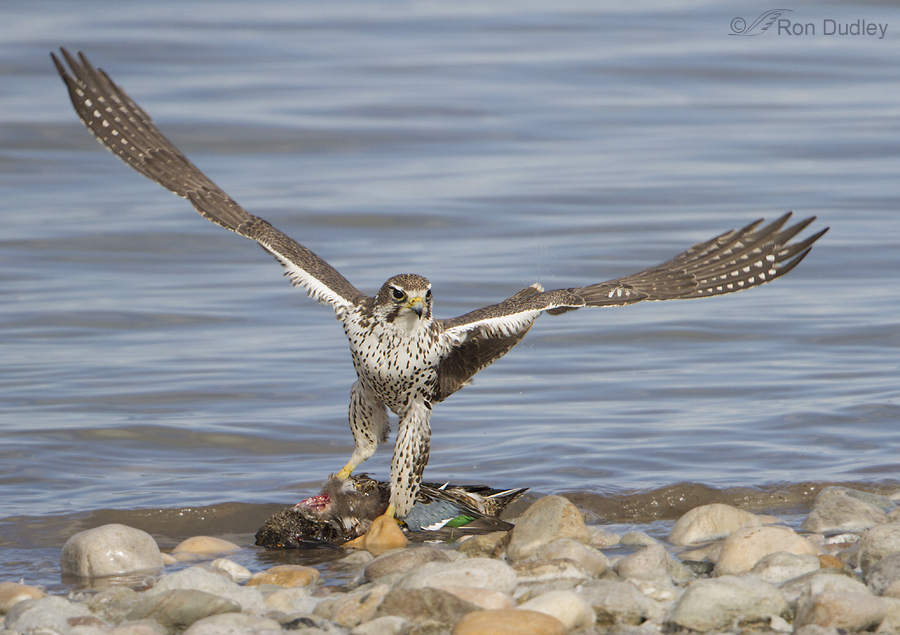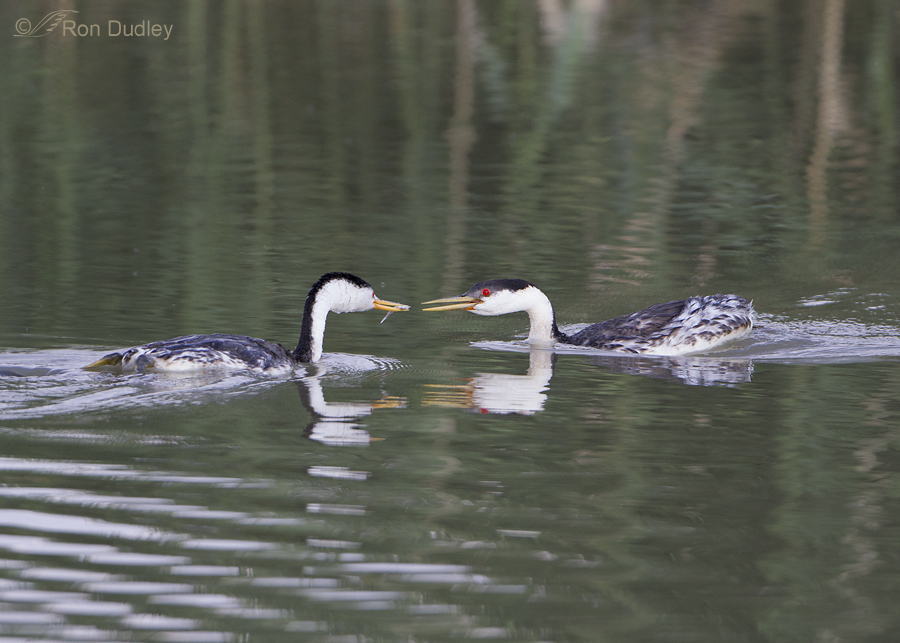Category: Feeding
Hummingbirds, Butterflies And Rocky Mountain Bee Plant
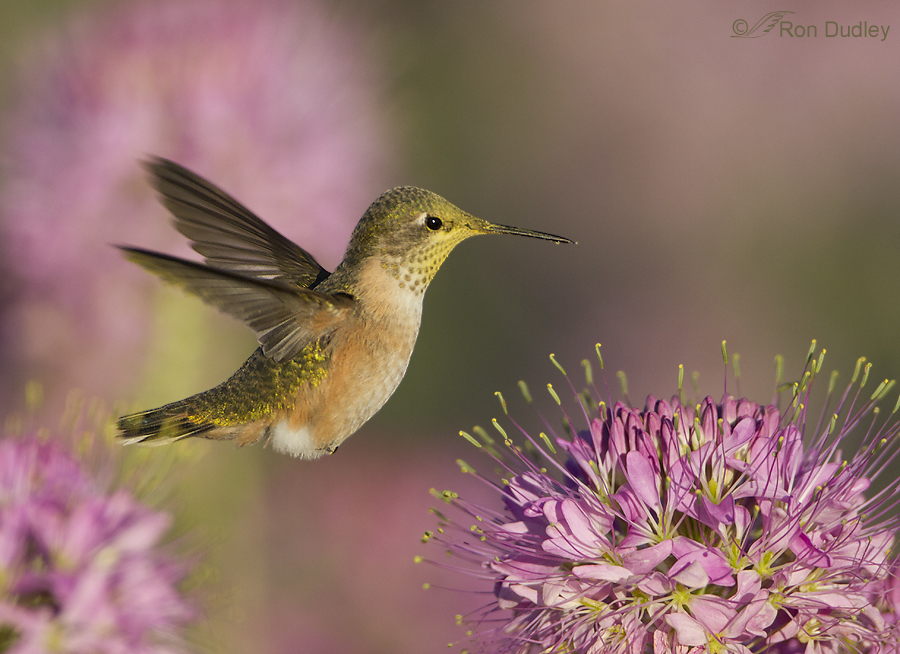
Yesterday morning on Antelope Island hummingbirds were buzzing frantically over clumps of Rocky Mountain Bee Plant, a species of Cleome that produces copious amounts of nectar so it attracts hummingbirds, butterflies, bees and wasps. All four were present. As a biologist I enjoyed watching the natural processes at work here. The long, showy pollen tipped stamens and deeply buried nectar, when combined with the long bill of the bird, are the perfect combination to suit some of the biological needs of each species. The hummers were often covered with pollen.
Montana Prairie Falcons And Hordes of Grasshoppers
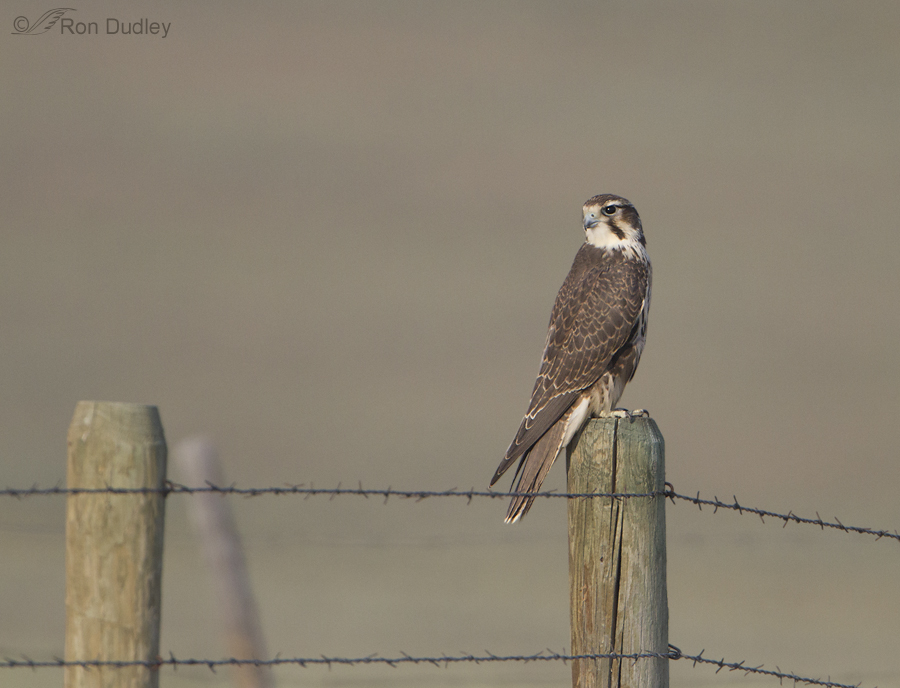
I learned something last week in Montana’s Centennial Valley – Prairie Falcons eat insects.
In the past I’ve only seen them eat birds and small mammals and cursory research had backed up that observation but if you dig a little deeper in your research (Birds of North America Online, for example) you’ll find mention of lizards and insects being included in their diet. My friend (master falconer) Mark Runnels says that “Prairie Falcons will eat anything. In really bad years I have even heard of them feeding on carrion. You’ll never see a Peregrine do that!”
Western Grebe Mated With Clark’s Grebe
Fledgling Loggerhead Shrike Begging For Food
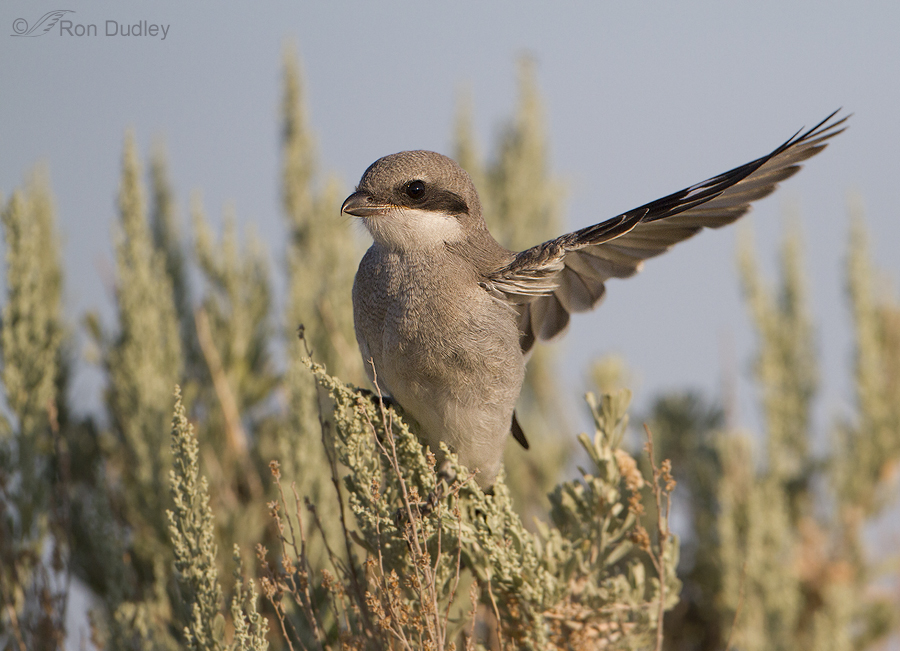
I photographed a family of very cooperative Loggerhead Shrikes last week on Antelope Island. The young birds had already fledged and were very actively exploring their world, strengthening their wing muscles by flying from perch to perch and testing a variety of objects for their potential food value.
And they were gutsy! Several times a juvenile landed on the tailgate of my pickup as you can see here.
American Kestrel With Snake Prey
Anyone who follows my blog knows that I observe and photograph kestrels often but I’ve never before seen one with snake prey. In my experience it’s always been voles, mice, small birds or (less often) insects. When we first noticed this bird it already had the snake on this bush perch.
Loggerhead Shrike – The Bill Of A Killer
I’ve never been able to get a really good look at both the hook and tomial teeth on the bill of a Loggerhead Shrike in any of my images. Until two days ago on Antelope Island…
Canvasbacks – Feeding and Fighting
Because of its striking appearance the Canvasback is often referred to as the “aristocrat” of ducks. But as you’ll see, it’s difficult to look aristocratic with your face, head and neck slathered in mud.
Great Blue Heron Canopy Feeding?
I’ve spent a fair number of years now photographing Great Blue Herons and I’d never before seen this behavior from the species.
Ravenous Yellow-headed Blackbird Fledgling
I was photographing adult male blackbirds when suddenly this very recently fledged youngster popped up in the cattails right in front of me. At first I thought it was just curious about me and my big truck but that turned out not to be the case.
Rough-legged Hawk With A Peculiar Hunting Technique
I’ve spent many hours watching Rough-legged Hawks hunt. Nearly always they hunt from the air or from elevated perches but several years ago this bird showed me a technique I had never seen before and haven’t since. All of these images are presented in the order they were taken. Techs for these shots were: 1/2000 – 1/3200, f/8. ISO 400, 500 f/4, 1.4 tc, natural light, not baited, set up or called in I found the hawk on the ground and as I approached it in my pickup it didn’t fly off as I expected it would. Here it’s looking at me but most of the time it was scanning the grasses in the vicinity – obviously hunting for voles from the ground. It would lift off but only fly a few feet before it landed again. In this first lift-off it had vegetation in its talons. I’ve seen them do this before – it’s almost like they’re reluctant to let go of the plant material after they’ve missed the prey. The hawk landed again… And intensely scanned the surrounding area for prey. Then another take-off… and it flew within inches of the ground… before it pounced on a vole and swallowed it. Then it continued to hunt in the same manner. Another take-off… and another. There’s blood on the right foot from the last vole. The hawk repeatedly did the same thing – take…
Mucus-drinking Cowbird
Before Europeans came to North America and cleared forests which modified the environment into the agricultural and suburban landscapes of today, the range of the Brown-headed Cowbird was limited to the short-grass plains where they followed the almost endless herds of American Bison as they fed on the insects stirred up by those wandering behemoths. Early settlers so strongly associated them with bison that they were called “Buffalo Birds”. Today that relationship still exists wherever limited numbers of bison can still be found. Antelope Island is one of those places. One of the many challenges facing the cowbird was obtaining enough moisture as it followed the bison herds over the hot, rolling plains. In late summer several years ago I photographed a cowbird behavior that illustrated one of the ways they solved that problem. I found this huge bull languishing in the broiling sun next to a boulder that it had been using as a scratching post. A group of Brown-headed Cowbirds were in the vicinity but at first I wasn’t paying much attention to them. Then this female (at frame bottom) flew in close… and began flying at the nostrils of the bull. Initially I was unsure about what she was doing but she did it repeatedly and eventually it became clear that she was… drinking the mucus-laden secretions from the bison’s nostrils. She would actually hover in place as she gobbled down the long, stringy strands of mucus. Not a pretty sight and perhaps a bit unsettling to our human sensibilities but what an incredibly adaptive behavior…
A Shrike Partially Consumes Its Own Pellet
This post is documentary only. The images are not aesthetically pleasing. Loggerhead Shrikes produce a pellet from an insect meal only 35.5 minutes (on average) after consumption. This is an amazingly fast turn-around time (Short-eared Owls average 8.5 hours before a pellet is produced from their rodent prey). When shrikes are consuming insects and spiders their pellets consist of the indigestible chitinous exoskeletons of those arthropods. I’ve seen and photographed Loggerhead Shrikes ejecting pellets many times but what I photographed on this August morning was new to me. Because of the cluttered setting I was mostly only watching this juvenile through my lens (not photographing it) when I could tell it was about to chuck up a pellet. Every time I’ve observed this behavior in the past the pellet was ejected quickly and cleanly and simply fell to the ground. But this bird had a surprise for me. It caught the pellet in the tip of its beak… and manipulated it there for some time. Then it very deliberately mashed up the pellet and appeared to be swallowing parts of it as other smaller pieces fell to the ground. My guess would be that about half of the pellet was consumed as the other half fell away, though I can’t be absolutely certain that any of it was actually eaten because my view of what was happening was not always a clear one. I wish I knew what was really going on here. This is the only time I’ve ever seen a bird (of any species) manipulate a pellet after…
Terns – After The Dive
Terns tend to be graceful and highly maneuverable flyers and those skills are very much on display when they’re fishing. 1/5000, f/6.3, ISO 500, 500 f/4, 1.4 tc, natural light I found this Forster’s Tern fishing at Bear River MBR last June and decided I’d attempt to photograph it coming out of the water after a dive – easier said than done. And to catch it with a fish would be a bonus. This species is known for feeding on “small” fish but this one is ridiculous – hardly worth the bother. If you look very carefully you can see the miniscule fish behind the upper part of the bill. I’ve cropped this shot unconventionally in order to include the “splash” behind the bird. These birds fish relentlessly. Their quarry is small, as is their success rate. In one Forster’s Tern study, 1538 dives produced 369 fish for a success rate of 24%. 1/5000, f/6.3, ISO 500, 500 f/4, 1.4 tc, natural light The fish is more easily seen in this next shot. When they come off the surface they usually shake excess water out of their feathers in mid-air. I caught this tern just before the shake, where it has twisted its wings in order to get good action for the upcoming shake. I missed the shake with this bird but… 1/1250, f/6.3, ISO 500, 500 f/4, 1.4 tc, natural light I did manage to capture it on another day with this Caspian Tern. I didn’t have enough shutter speed to get the quick movements particularly sharp but…
Western Grebe Fish Delivery
Temperatures are finally warming a bit here in northern Utah but the world is outside is still monotonously white. Yesterday morning I measured 22 1/2″ of snow on the north end of Antelope Island, indicating that our bleak and largely featureless landscape will remain the same for the foreseeable future. So this morning I needed a break and decided to post an image (taken this past June at Bear River MBR) that would remind me that spring is somewhere out there on the distant horizon. 1/3200, f/7.1, ISO 640, 500 f/4, 1.4 tc, natural light Western Grebes are devoted parents to their incessantly hungry and noisy chicks. The male and female take turns with their parental duties – one will back brood the youngsters while the other delivers fish and then they alternate responsibilities. Here the female (smaller than the male, with a shorter, thinner bill – thus sexual dimorphism) has caught a small fish and is delivering it to the male. Usually the parent receiving the fish will give it to the chick, as happened here. As I’m sure is obvious, I’m very much looking forward to watching and photographing springtime bird activities once again. It’s going to be a very long 2-3 months… Ron
Hummingbirds, Butterflies And Rocky Mountain Bee Plant

Yesterday morning on Antelope Island hummingbirds were buzzing frantically over clumps of Rocky Mountain Bee Plant, a species of Cleome that produces copious amounts of nectar so it attracts hummingbirds, butterflies, bees and wasps. All four were present. As a biologist I enjoyed watching the natural processes at work here. The long, showy pollen tipped stamens and deeply buried nectar, when combined with the long bill of the bird, are the perfect combination to suit some of the biological needs of each species. The hummers were often covered with pollen.
Montana Prairie Falcons And Hordes of Grasshoppers

I learned something last week in Montana’s Centennial Valley – Prairie Falcons eat insects.
In the past I’ve only seen them eat birds and small mammals and cursory research had backed up that observation but if you dig a little deeper in your research (Birds of North America Online, for example) you’ll find mention of lizards and insects being included in their diet. My friend (master falconer) Mark Runnels says that “Prairie Falcons will eat anything. In really bad years I have even heard of them feeding on carrion. You’ll never see a Peregrine do that!”
Western Grebe Mated With Clark’s Grebe
Fledgling Loggerhead Shrike Begging For Food

I photographed a family of very cooperative Loggerhead Shrikes last week on Antelope Island. The young birds had already fledged and were very actively exploring their world, strengthening their wing muscles by flying from perch to perch and testing a variety of objects for their potential food value.
And they were gutsy! Several times a juvenile landed on the tailgate of my pickup as you can see here.
American Kestrel With Snake Prey
Anyone who follows my blog knows that I observe and photograph kestrels often but I’ve never before seen one with snake prey. In my experience it’s always been voles, mice, small birds or (less often) insects. When we first noticed this bird it already had the snake on this bush perch.
Loggerhead Shrike – The Bill Of A Killer
I’ve never been able to get a really good look at both the hook and tomial teeth on the bill of a Loggerhead Shrike in any of my images. Until two days ago on Antelope Island…
Canvasbacks – Feeding and Fighting
Because of its striking appearance the Canvasback is often referred to as the “aristocrat” of ducks. But as you’ll see, it’s difficult to look aristocratic with your face, head and neck slathered in mud.
Great Blue Heron Canopy Feeding?
I’ve spent a fair number of years now photographing Great Blue Herons and I’d never before seen this behavior from the species.
Ravenous Yellow-headed Blackbird Fledgling
I was photographing adult male blackbirds when suddenly this very recently fledged youngster popped up in the cattails right in front of me. At first I thought it was just curious about me and my big truck but that turned out not to be the case.
Rough-legged Hawk With A Peculiar Hunting Technique
I’ve spent many hours watching Rough-legged Hawks hunt. Nearly always they hunt from the air or from elevated perches but several years ago this bird showed me a technique I had never seen before and haven’t since. All of these images are presented in the order they were taken. Techs for these shots were: 1/2000 – 1/3200, f/8. ISO 400, 500 f/4, 1.4 tc, natural light, not baited, set up or called in I found the hawk on the ground and as I approached it in my pickup it didn’t fly off as I expected it would. Here it’s looking at me but most of the time it was scanning the grasses in the vicinity – obviously hunting for voles from the ground. It would lift off but only fly a few feet before it landed again. In this first lift-off it had vegetation in its talons. I’ve seen them do this before – it’s almost like they’re reluctant to let go of the plant material after they’ve missed the prey. The hawk landed again… And intensely scanned the surrounding area for prey. Then another take-off… and it flew within inches of the ground… before it pounced on a vole and swallowed it. Then it continued to hunt in the same manner. Another take-off… and another. There’s blood on the right foot from the last vole. The hawk repeatedly did the same thing – take…
Mucus-drinking Cowbird
Before Europeans came to North America and cleared forests which modified the environment into the agricultural and suburban landscapes of today, the range of the Brown-headed Cowbird was limited to the short-grass plains where they followed the almost endless herds of American Bison as they fed on the insects stirred up by those wandering behemoths. Early settlers so strongly associated them with bison that they were called “Buffalo Birds”. Today that relationship still exists wherever limited numbers of bison can still be found. Antelope Island is one of those places. One of the many challenges facing the cowbird was obtaining enough moisture as it followed the bison herds over the hot, rolling plains. In late summer several years ago I photographed a cowbird behavior that illustrated one of the ways they solved that problem. I found this huge bull languishing in the broiling sun next to a boulder that it had been using as a scratching post. A group of Brown-headed Cowbirds were in the vicinity but at first I wasn’t paying much attention to them. Then this female (at frame bottom) flew in close… and began flying at the nostrils of the bull. Initially I was unsure about what she was doing but she did it repeatedly and eventually it became clear that she was… drinking the mucus-laden secretions from the bison’s nostrils. She would actually hover in place as she gobbled down the long, stringy strands of mucus. Not a pretty sight and perhaps a bit unsettling to our human sensibilities but what an incredibly adaptive behavior…
A Shrike Partially Consumes Its Own Pellet
This post is documentary only. The images are not aesthetically pleasing. Loggerhead Shrikes produce a pellet from an insect meal only 35.5 minutes (on average) after consumption. This is an amazingly fast turn-around time (Short-eared Owls average 8.5 hours before a pellet is produced from their rodent prey). When shrikes are consuming insects and spiders their pellets consist of the indigestible chitinous exoskeletons of those arthropods. I’ve seen and photographed Loggerhead Shrikes ejecting pellets many times but what I photographed on this August morning was new to me. Because of the cluttered setting I was mostly only watching this juvenile through my lens (not photographing it) when I could tell it was about to chuck up a pellet. Every time I’ve observed this behavior in the past the pellet was ejected quickly and cleanly and simply fell to the ground. But this bird had a surprise for me. It caught the pellet in the tip of its beak… and manipulated it there for some time. Then it very deliberately mashed up the pellet and appeared to be swallowing parts of it as other smaller pieces fell to the ground. My guess would be that about half of the pellet was consumed as the other half fell away, though I can’t be absolutely certain that any of it was actually eaten because my view of what was happening was not always a clear one. I wish I knew what was really going on here. This is the only time I’ve ever seen a bird (of any species) manipulate a pellet after…
Terns – After The Dive
Terns tend to be graceful and highly maneuverable flyers and those skills are very much on display when they’re fishing. 1/5000, f/6.3, ISO 500, 500 f/4, 1.4 tc, natural light I found this Forster’s Tern fishing at Bear River MBR last June and decided I’d attempt to photograph it coming out of the water after a dive – easier said than done. And to catch it with a fish would be a bonus. This species is known for feeding on “small” fish but this one is ridiculous – hardly worth the bother. If you look very carefully you can see the miniscule fish behind the upper part of the bill. I’ve cropped this shot unconventionally in order to include the “splash” behind the bird. These birds fish relentlessly. Their quarry is small, as is their success rate. In one Forster’s Tern study, 1538 dives produced 369 fish for a success rate of 24%. 1/5000, f/6.3, ISO 500, 500 f/4, 1.4 tc, natural light The fish is more easily seen in this next shot. When they come off the surface they usually shake excess water out of their feathers in mid-air. I caught this tern just before the shake, where it has twisted its wings in order to get good action for the upcoming shake. I missed the shake with this bird but… 1/1250, f/6.3, ISO 500, 500 f/4, 1.4 tc, natural light I did manage to capture it on another day with this Caspian Tern. I didn’t have enough shutter speed to get the quick movements particularly sharp but…
Western Grebe Fish Delivery
Temperatures are finally warming a bit here in northern Utah but the world is outside is still monotonously white. Yesterday morning I measured 22 1/2″ of snow on the north end of Antelope Island, indicating that our bleak and largely featureless landscape will remain the same for the foreseeable future. So this morning I needed a break and decided to post an image (taken this past June at Bear River MBR) that would remind me that spring is somewhere out there on the distant horizon. 1/3200, f/7.1, ISO 640, 500 f/4, 1.4 tc, natural light Western Grebes are devoted parents to their incessantly hungry and noisy chicks. The male and female take turns with their parental duties – one will back brood the youngsters while the other delivers fish and then they alternate responsibilities. Here the female (smaller than the male, with a shorter, thinner bill – thus sexual dimorphism) has caught a small fish and is delivering it to the male. Usually the parent receiving the fish will give it to the chick, as happened here. As I’m sure is obvious, I’m very much looking forward to watching and photographing springtime bird activities once again. It’s going to be a very long 2-3 months… Ron


